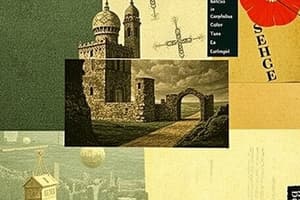Podcast
Questions and Answers
¿Cuál es el nombre del metrical form que se caracteriza por tener cuatro líneas de alexandrina con 14 sílabas cada una?
¿Cuál es el nombre del metrical form que se caracteriza por tener cuatro líneas de alexandrina con 14 sílabas cada una?
- Verso alejandrino
- Ritmo clerical
- Cuaderna vía (correct)
- Metro juglaresco
¿Qué género de literatura española se caracterizó por tener un estilo más formalizado y un enfoque en temas serios?
¿Qué género de literatura española se caracterizó por tener un estilo más formalizado y un enfoque en temas serios?
- Romance cortesano
- Mester de Clerecía (correct)
- Mester de Juglaría
- Poesía trovadoresca
¿Quién es el autor más destacado asociado con el Mester de Clerecía?
¿Quién es el autor más destacado asociado con el Mester de Clerecía?
- Juan Ruiz
- Fernando de Rojas
- Gonzalo de Berceo (correct)
- Alfonso X el Sabio
¿Cuál es el nombre del término que se refiere a la 'craft of the clergy' en el contexto del Mester de Clerecía?
¿Cuál es el nombre del término que se refiere a la 'craft of the clergy' en el contexto del Mester de Clerecía?
¿Cuál es el siglo en que el Mester de Clerecía surgió en la literatura española?
¿Cuál es el siglo en que el Mester de Clerecía surgió en la literatura española?
¿Cuál es el impacto más significativo del Mester de Clerecía en la literatura española medieval?
¿Cuál es el impacto más significativo del Mester de Clerecía en la literatura española medieval?
¿Quién es el poeta conocido por utilizar la cuaderna vía en partes de su famosa obra, Libro de buen amor?
¿Quién es el poeta conocido por utilizar la cuaderna vía en partes de su famosa obra, Libro de buen amor?
¿Cuál es el nombre del género literario que se caracteriza por la utilización de la cuaderna vía?
¿Cuál es el nombre del género literario que se caracteriza por la utilización de la cuaderna vía?
¿Quién es el príncipe que escribió en una variedad de estilos prosísticos?
¿Quién es el príncipe que escribió en una variedad de estilos prosísticos?
¿Cuál es el rasgo más destacado de la poesía del Mester de Clerecía?
¿Cuál es el rasgo más destacado de la poesía del Mester de Clerecía?
Flashcards are hidden until you start studying
Study Notes
Mester de Clerecía: The Clerical Ministry in Medieval Spanish Literature
The Mester de Clerecía, also known as the "Ministry of Clergy," was a genre of Spanish literature that emerged in the 13th century and marked a significant shift from the oral tradition of Mester de Juglaría. This movement was characterized by a more formalized written style, stricter metrical restrictions, and a focus on serious topics such as religion, history, and novelesque themes.
Origins and Development
The terms "Mester de Clerecía" and "Mester de Juglaría" evolved from the 12th-13th centuries. Mester de Juglaría was an oral tradition transmitted by traveling entertainers, while Mester de Clerecía was a written form created by more educated authors. The term "mester" originally referred to a craft or trade, and in this context, it represented the "craft of the clergy".
The Mester de Clerecía was distinguished by its use of a specific metrical form, the cuaderna vía, which consists of four alexandrine lines with 14 syllables each. This format was popular until the late 14th century and was borrowed from France.
Key Works and Authors
Some of the most prominent works and authors associated with the Mester de Clerecía include:
- Gonzalo de Berceo: A Castilian priest and poet, Berceo is one of the greatest followers of the Mester de Clerecía. All of his works were religious, and two of his most well-known pieces are Milagros de Nuestra Señora and Vida de Santa Oria.
- Juan Ruiz (Arcipreste de Hita): A 14th-century poet known for his use of the cuaderna vía in parts of his famous work, Libro de buen amor, which introduced sixteen-syllable lines.
Influence and Legacy
The Mester de Clerecía had a significant impact on the development of medieval Spanish literature. Its influence can be seen in the works of other poets, such as Sem Tob de Carrión, a Jewish poet born towards the end of the 13th century, and Juan Manuel, Prince of Villena, who wrote in a variety of prose styles.
In conclusion, the Mester de Clerecía represented a significant shift in medieval Spanish literature, moving from an oral tradition to a more formalized, written style with stricter metrical restrictions and a focus on serious topics. The works of authors like Gonzalo de Berceo and Juan Ruiz continue to influence the study and appreciation of Spanish literature today.
Studying That Suits You
Use AI to generate personalized quizzes and flashcards to suit your learning preferences.




